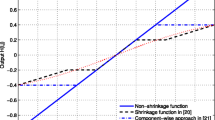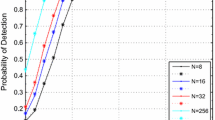Abstract
Spectrum sensing is a key technology to detect spectrum holes in cognitive network. It has been demonstrated that collaboration among cognitive users can improve the probability of detecting the primary users, but the fusion center is the bottleneck when a lot of collaborative information is transmitted. In this paper, we consider the cognitive radio users only transmit part of sensing information to relieve the transmission load. Besides, the sensing information will be inevitably influenced by various noise in the process of transmission. Therefore, the challenge is how we can detect spectrum holes successfully from these incomplete and inexact measurements. Most recently, there are some research results on this but the detection performance is not satisfactory. In this paper, we firstly formulate the collaborative spectrum sensing as an optimization model and then present a novel adaptive orthogonal matching pursuit algorithm by exploiting the sparsity of active primary users. Statistical property of the sensing data plays a crucial role in spectrum sensing. Theoretical analysis shows the presented scheme can detect active primary users rapidly and efficiently. Simulation results verify that the proposed method can obtain better detection performance with stronger noise background, which is more attractive in real applications.









Similar content being viewed by others
References
Cordeiro, C., Challapali, K., & Birru, D. (2006). IEEE 802.22: An introduction to the first wireless standard based on cognitive radios. Journal of Communications, 1(1), 38–47.
Niyato, D., Hossain, E., & Han, Z. (2009). Dynamics of multiple-seller and multiple-buyer spectrum trading in cognitive radio networks: A game theoretic modeling approach. IEEE Transactions on Mobile Computing, 8(8), 1009–1022.
Rashid, M. M., Hossain, M. J., Hossain, E., & Bhargava, V. K. (2009). Opportunistic spectrum scheduling for multiuser cognitive radio: A queueing analysis. IEEE Transactions on Wireless Communications, 8(10), 5259–5269.
Hoang, A. T., Liang, Y. C., & Zeng, Y. H. (2010). Adaptive joint scheduling of spectrum sensing and data transmission in cognitive radio networks. IEEE Transactions on Communications, 58(1), 235–246.
Li, D., Xu Y., Xinbing W., Guizani, M. (2011). Coalitional game theoretic approach for secondary spectrum access in cooperative cognitive radio networks. IEEE Transactions on Wireless Communications, 10(3), 844–856.
Deepak, J., Popescu, D. C., & Dobre, O. A. (2010). Gradient-based threshold adaptation for energy detector in cognitive radio systems. IEEE Communications Letters, 15(1), 19–21.
Wang, B., Wu, Y., & Liu, K. J. R. (2010) Game theory for cognitive radio networks: An overview. Computer Networks, 54, 2537–2561.
Akyildiz, I. F., Lo, B. F., & Balakrishnan, R. (2011). Cooperative spectrum sensing in cognitive radio networks: A survey. Physical Communication (Elsevier) Journal, 4(1), 40–62.
Visotsky, E., Kuffner, S., & Peterson, R. (2005). On collaborative detection of TV transmissions in support of dynamic spectrum sensing. In proc. of IEEE Symp. New Frontiers in Dynamic Spectrum Access Networks, Baltimore, USA, pp. 338–345.
Zhang, W. & Letaief, K. B. (2008). Cooperative spectrum sensing with transmit and relay diversity in cognitive networks. IEEE Transactions on Wireless Communications, 7:4761–4766.
Candès, E. (2006). Compressive sampling. In Proceedings of the International Congress of Mathematicians, Madrid, Spain, 1433–1452.
Donoho, D. (2006). Compressed sensing. IEEE Transactions on Information Theory, 52(4), 1289–1306.
Tian, Z., & Giannakis, G. B. (2007). Compressed sensing for wideband cognitive radio. ICASSP, 4, 1357–1360.
Bazerque, J. A., & Giannakis, G. B. (2010). Distributed spectrum sensing for cognitive radio networks by exploiting sparsity. IEEE Transactions on Signal Processing, 58, 1847–1862.
Meng, J., Yin, W., Li, H., Houssain, E., & Han, Z. (2010). Collaborative spectrum sensing from sparse observations using matrix completion for cognitive radio networks. 35th International Conference on Acoustics, Speech, and Signal Processing (ICASSP).
Meng, J., Yin, W., Li, H., Houssain, E., & Han, Z. (2011). Collaborative spectrum sensing from sparse observations in cognitive radio networks. IEEE Journal on Selected Areas in Communications, 29(2), 327–337.
Cotter, S. F., Rao, B. D., Engan, K., & Delgado, K. K. (2005). Sparse solutions to linear inverse problems with multiple measurement vectors. IEEE Transactions on Signal Processing, 53, 2477–2488.
Mishali, M., & Eldar, Y. C. (2008). Reduce and boost: Recovering arbitrary sets of jointly sparse vectors. IEEE Transactions on Signal Processing, 56, 4692–4702.
van den Berg, E., & Friedlander, M. P. (2010). Theoretical and empirical results for recovery from multiple measurements. IEEE Transactions on Information Theory, 56, 2516–2527.
Jiao, L. C., Jianrui C., etc (2011). Efficient collaborative Spectrum sensing with low sample rate. Wireless Personal Communications. doi:10.1007/s11277-011-0419-z.
Donoho, D. L., Tsaig, Y., Drori, I., Starck, J.-L. (2006). Sparse solution of underdetermined linear equations by stagewise orthogonal matching pursuit, Technical Report, Department of Statistics, Stanford University.
Needell, D., & Tropp, J. A. (2009). CoSaMP: Iterative signal recovery from incomplete and inaccurate samples. Applied and Computational Harmonic Analysis, 26, 301–321.
Jaynes, E. T. (2003). Probability Theory: The Logic of Science. Cambridge University Press.
Candès, E. J., & Tao, T. (2006). Near optimal signal recovery from random projections: Universal encoding strategies. IEEE Transactions on Information Theory, 52, 5406–5425.
NTIA, FCC (frequency allocation chart). (2003). Available at http://www.ntia.doc.gov/osmhome/allochrt.pdf.
Acknowledgments
This research was supported through the National Natural Science Foundation of China under Grant (No. 61072139, No. 61072106, No. 61003199); the Key Scientific and Technological Innovation Special Projects of Shan’Xi "13115” (No. 2008ZDKG-37); the Fund for Foreign Scholars in University Research and Teaching Programs (the 111 Project) (No. B07048); the Fundamental Research Funds for the Central Universities (JY10000902001, JY10000970001, JY10000902036); the Open Research Fund Program of Key Lab of Intelligent Perception and Image Understanding of Ministry of Education of China under Grant: IPIU012011003; Inner Mongolia University of Technology: ZD201221.
Author information
Authors and Affiliations
Corresponding author
Rights and permissions
About this article
Cite this article
Chen, J., Jiao, L.C., Wu, J. et al. Compressive spectrum sensing in the cognitive radio networks by exploiting the sparsity of active radios. Wireless Netw 19, 661–671 (2013). https://doi.org/10.1007/s11276-012-0493-5
Published:
Issue Date:
DOI: https://doi.org/10.1007/s11276-012-0493-5




